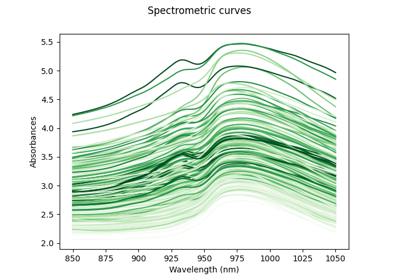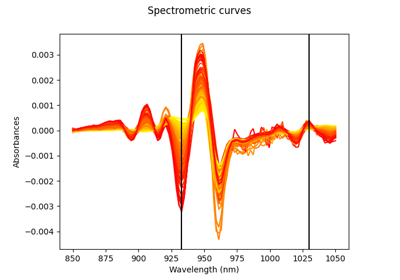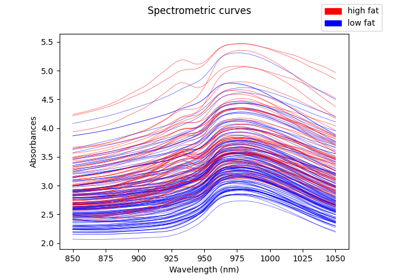fetch_tecator#
- skfda.datasets.fetch_tecator(*, return_X_y: Literal[False] = False, as_frame: bool = False) Bunch[source]#
- skfda.datasets.fetch_tecator(*, return_X_y: Literal[True], as_frame: Literal[False] = False) Tuple[FDataGrid, ndarray[Any, dtype[float64]]]
- skfda.datasets.fetch_tecator(*, return_X_y: Literal[True], as_frame: Literal[True]) Tuple[DataFrame, DataFrame]
Load the Tecator dataset.
The data is obtained from the R package ‘fda.usc’, which takes it from http://lib.stat.cmu.edu/datasets/tecator.
This is the Tecator data set: The task is to predict the fat content of a meat sample on the basis of its near infrared absorbance spectrum.
Statement of permission from Tecator (the original data source)
These data are recorded on a Tecator Infratec Food and Feed Analyzer working in the wavelength range 850 - 1050 nm by the Near Infrared Transmission (NIT) principle. Each sample contains finely chopped pure meat with different moisture, fat and protein contents.
If results from these data are used in a publication we want you to mention the instrument and company name (Tecator) in the publication. In addition, please send a preprint of your article to
Karin Thente, Tecator AB, Box 70, S-263 21 Hoganas, Sweden
The data are available in the public domain with no responsability from the original data source. The data can be redistributed as long as this permission note is attached.
For more information about the instrument - call Perstorp Analytical’s representative in your area.
Description of the data
For each meat sample the data consists of a 100 channel spectrum of absorbances and the contents of moisture (water), fat and protein. The absorbance is -log10 of the transmittance measured by the spectrometer. The three contents, measured in percent, are determined by analytic chemistry.
There are 215 samples.
- Parameters:
return_X_y – Return only the data and target as a tuple.
as_frame – Return the data in a Pandas Dataframe or Series.
Examples using skfda.datasets.fetch_tecator#

Functional Principal Component Analysis Regression.

Spectrometric data: derivatives, regression, and variable selection


